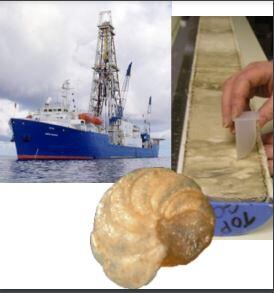Deep ocean temperatures during Eocene greenhouse climates – assessing inter-basin gradients
This Master's project was assigned to Eirik Asbjørnsen who started the Master's program in Earth sciences, UiB, fall 2024. The Master's project is given by the research group Quaternary geology & paleo climate.
Hovedinnhold
Project description
Motivation (background): The Eocene (~55-34 million years ago) was characterized by global warmth and little to no glaciation. Reconstructing climate during this time gives us an opportunity to understand how the climate system behaves in such a warmer greenhouse state, possibly resembling future climate conditions. Much of our current understanding of Eocene climate relies on classical oxygen isotope thermometry in marine microfossils, assuming that temperature is the main control on these signals. However, this ignores several other possible influences, such as changes in ocean salinity.
Fortunately, we have a new tool to get more reliable estimates of past ocean temperatures, using isotopes in carbonates in a slightly different way: Clumped isotope thermometry allows reconstructing temperatures from carbonates based on the ordering ("clumping") of stable isotopes within the molecules. Unlike other carbonate-based temperature proxies, this method is independent of limiting assumptions about source water composition, thereby yielding better constraints on paleotemperatures. This approach is also of great interest to other Earth Science disciplines (e.g., tectonics, petroleum science, planetary science).
Our first results for the Eocene show large variations in ocean temperatures that have not previously been recognized. These findings point to variations in ocean circulation that were likely connected to variations in atmospheric CO2 and led to major climate events, such as the glaciation of Antarctica at the end of the Eocene. In this master project, the goal is to investigate these fluctuations in more detail to better understand their timing, geographic extent, and connection to other reconstructed climate changes.
The master student will be part of a team that studies Paleocene-Eocene climate based on carbonate clumped isotope thermometry on foraminifera from selected marine core locations, with samples provided by the International Ocean Discovery Program (IODP). We also collaborate with climate modelers at the Bjerknes Centre to put our results into global perspective.
Research question: How variable was the temperature in the deep ocean during the Eocene greenhouse climate and how do variations connect to known climate events during this time period?
Proposed course plan during the master's degree (60 ECTS):
The following selection is a suggestion and can be discussed:
GEOV222 (10P)
GEOV228 (10P)
GEOV302 (10P)
GEOV231 (10P)
GEOV331 (5P)
GEOV300 (5P)
free choice (10P)
Field- lab- and analysis
The samples come from IODP core repositories. They need to be wet-sieved before benthic foraminifera will be picked from the sediment samples under a microscope and prepared for analysis. Measurements are done on a clumped isotope mass spectrometer under guidance. Clumped isotope values will be converted to temperature estimates using a calibration curve. The data will be compared to data from other proxies from the same and nearby sites and to other clumped isotope data obtained in our team at other sites. Total estimated lab/analysis time: 6 months.
